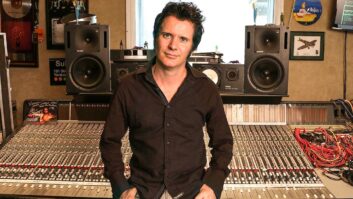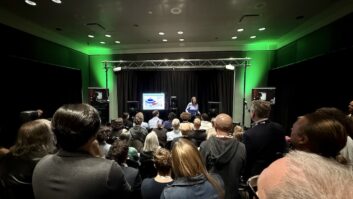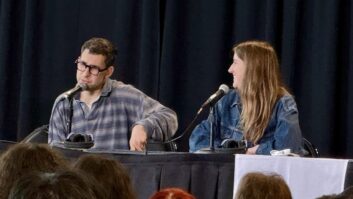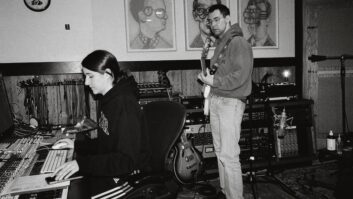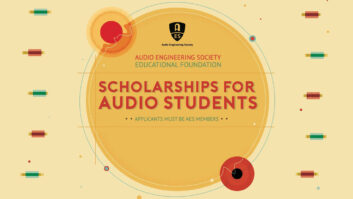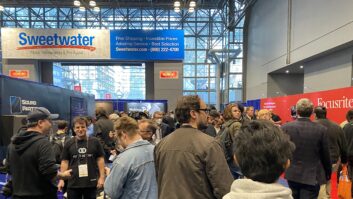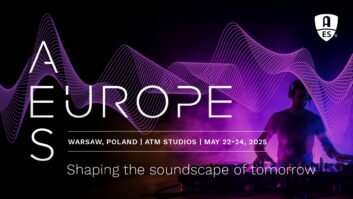
For many audio companies, 2003 proved to be a significant year. We decided to spotlight a few of the companies celebrating anniversaries at AES.
EASTERN ACOUSTIC WORKS: 25 YEARS
In 1978, EAW founders Ken Berger and Kenton Forsythe and a handful of employees set up shop in an old automobile plant in Framingham, Mass. From the start, their intent was to create high-quality touring loudspeakers, but at the time, the duo had no idea how influential their products would be in helping change the direction of an entire industry.
In a few short years, EAW succeeded in developing stock products that regional and national sound companies could use right out of the carton. The days of a sound company needing to build all of its enclosures were numbered. This trend was accelerated with the 1985 debut of the hugely successful KF850, a three-way, tri-amped, horn-loaded, Virtual Array™ system that five years later appeared on more riders than any other loudspeaker.
At the time, consumer interest in the new CD format brought increasing requirements for better sound in performance spaces, whether in concert halls, houses of worship, clubs, live theater and stadiums, or racetracks and other sports venues. In 1989, EAW’s first major installation — a complex system for the Anaheim, Calif., baseball stadium — both presented EAW as a capable, on-time supplier in the fixed-install market, and also fueled the movement toward hi-fi/high-SPL sports venues, driven by EAW’s creation of new application-specific products. This approach was also successfully carried forward with the company’s entry into the cinema market in 1995, with THX-approved, three-way products that were far ahead of the traditional two-way designs found in most cinemas.
In 1999, EAW purchased SIA Software, creators of the SMAART audio measurement/analysis system. EAW itself was acquired by Mackie Designs in 2000, but the innovations continue unabated, such as its Digitally Steered Array Series that was shown earlier this year and is based on technology derived from its large-format KF900 system.
GENELEC: 25 YEARS
Finland may not be the first (or second or third!) country one thinks of when considering a pro audio supplier. However, during the past 25 years, Genelec has definitely been doing something right, leading to a long list of industry accolades, including an unprecedented six TEC Awards wins in the category of excellence in studio monitors, in 1992 (1031A), 1993 (1038A), 1995 (1030A), 1996 (1039A), 1997 (1029A/1091A) and 2000 (1036A).

Based on the shores of Finland’s Lake Porovesi, Genelec was founded in 1978 by Ilpo Martikainen, Topi Partanen and Ritva Leinonen, who still run the company. Genelec’s first project was to supply monitors for the Finnish Broadcasting Corporation complex in Helsinki. At the time, the term “powered monitor” referred to a speaker with an amplifier that was built-in for convenience rather than performance. But from the beginning, the Genelec philosophy was to create active monitors, where high-quality onboard amps were precisely matched to the speaker components to optimize system performance.
The concept gained popularity with broadcasters throughout Europe, and in the mid-1980s, Genelec expanded, offering products for the music studio market. The company then started developing a large main control room monitor, the Model 1035A, unveiled at the 1989 AES in Hamburg. The 1035A — and its proprietary Directivity Control Waveguide™ — provided the foundation for other Genelec monitors, large and small, which also shared the active powered approach, from the near/mid-field (1031A and 1030A) to the near-field satellite/subwoofer (1029A/1091A) system, to the large mains with external amp racks in the 1038A and 1036A monitors.
A more recent Genelec breakthrough is its Laminar Spiral Enclosure™ (LSE) subwoofer technology, which removes acoustic nonlinearities from port turbulence for a smooth “laminar flow” of LF energy from a rigid, tuned enclosure. Yet today or 25 years ago, the company philosophy remains unchanged, says president Martikainen: “At Genelec, we simply design monitors that speak the truth of the recording.”
PEAVEY MEDIAMATRIX: 10 YEARS
Exactly 10 years ago during AES, in a penthouse suite at the New York Hilton, Peavey Electronics and Peak Audio debuted a joint venture known today as MediaMatrix. Described by Hartley Peavey as an “Audio Erector Set,” the system combined an I/O connection box with an IBM PC and plug-in cards providing DSP horsepower for mixing, gating, EQ, compression, crossovers and delay. Users could create a system merely by dragging icons of various components (gates, preamps, etc.) into the desired configuration and drawing connection lines using a mouse. In those days before DSP plug-ins, the MediaMatrix was so far ahead of its time that many attendees at the unveiling left thinking that it was simply a CAD program for documenting systems rather than a radical approach that could create the equivalents of hardware boxes simply by allocating DSP reserves.

A well-established manufacturer of hardware, Peavey had some initial concerns that the technology could make obsolete a major portion of his livelihood, but went forward with the project under the insight that if such a product could exist, it would be better to be first than try to play catch-up later. He was 100% right. News of the announcement spread like wildfire, and within a matter of months, installations followed at prestigious venues such as the U.S. Senate and Disney’s Epcot Center, giving MediaMatrix a strong foothold among contractors and consultants.
Later MediaMatrix systems — such as the X-Frame and the X-Frame 88 — brought prices down to even lower levels, making the technology accessible to much smaller installs, as well as world-class venues like Tokyo Disney, the Sydney Opera House, dozens of major-league football and baseball stadiums, almost every casino in Las Vegas, the Sydney Olympics, the Opryland Convention Center and the Grand Mosque in Mecca — more than 2,500 worldwide.
SENNHEISER ELECTRONIC CORP.: 40 YEARS
SEC — the U.S. wing of Sennheiser — began in 1963 by Thomas Schillinger as a small independent distributor, selling MKH shotgun mics and the (still classic) MD421 dynamic to a few dealers, mostly in the film biz. Now headquartered in Old Lyme, Conn., SEC serves more than 1,500 pro and consumer dealers in the U.S. and Latin America, with lines including Sennheiser, Neumann, Turbosound, Chevin, True Audio and InnovaSon.

But unlike a typical “distributor,” SEC takes an active role in developing specialized products based on customer feedback. “We maintain an ongoing relationship with our customers,” explains current SEC president John Falcone. “We utilize their input as a resource, and match products and services to their specific needs.” One such example is the only selective-distribution system on the market, the SAS 432 wireless mic antenna splitter system, which can feed 32 wireless receivers from a single pair of antennas. It’s been used in award-winning Broadway productions such as The Lion King, Beauty and the Beast and Sunset Boulevard, but has since found use in NFL Football broadcasts and the Grammy™ Awards.
This company-wide commitment to listen, combined with top-end customer support and great products, has earned Sennheiser the distinction of being the only pro audio manufacturer to receive the “Triple Crown” of Oscar™, Emmy™ and Grammy Awards. These included a 1987 Scientific and Engineering Award from the Academy of Motion Picture Arts & Sciences for the industry-standard MKH 816 shotgun mic; a 1996 Emmy for developments in RF wireless technology; and a 1999 Technical Grammy Award for Neumann. Today, SEC faces an increasing number of uncertainties, whether it’s the tough economic environment, increased competition, higher technical standards or the seemingly endless maze of wireless regulations, so the next Oscar, Emmy or Grammy will not come easily. But since 1963, Sennheiser Electronics Corporation has never done things the easy way.
YAMAHA CONSOLES: 30/15
When it comes to consoles, everyone in pro audio knows the Yamaha name, and 2003 marks the dual anniversary of the company’s PM Series live boards (30 years) and 15 years of its digital consoles. Combining solid construction and high-quality audio, more than 9,000 PM Series live consoles and 110,000 digital mixers are in use worldwide.

The first PM mixers, such as the PM200 and PM300, were simple 8-input boards for portable applications, but Yamaha really stepped up with its 1976 PM1000-32 and 1978 PM2000, with enough flexibility for club and concert work. The defining moment came with the PM3000 in 1985, which added VCA control and became a workhorse in the touring industry for years. The tradition was continued and refined in 1992 with the PM4000 and the 1996 PM3500; both are still in use in concert venues everywhere. The PM1D all-digital console (2000) addressed the needs of modern sound reinforcement with its modular configuration, built-in effects and complete recall capability. Earlier this year, Yamaha showed its new flagship PM5000 analog console, combining high-performance analog with some of the control convenience derived from the PM1D.
Yamaha’s digital console program began with the 1988 debut of the DMP7, followed by the DMP7D (digital I/O version). There were other Yamaha mixers in the meantime (i.e., the DMC1000, DMP9 and ProMix 01), but the 02R changed everything. In 1995, the under-$10,000, 20-bit, digital, 8-bus 02R took off, offering 24 analog inputs and 16 digital tape returns (40 total inputs), moving faders, reset of all parameters, dynamics on every channel and two internal effects processors. Paired with a couple of MDMs, the all-digital studio was no longer a fantasy.
Followed by its 1997 03D and 1998 01V, Yamaha thoroughly established the genre of the affordable digital console. And with debuts of the DM2000, DM1000, 02R96 and 01V96 during the past year, offering full 96kHz performance with DAW integration and surround mixing, Yamaha is set to continue its role in defining the modern console for years to come.
Mix editorial director George Petersen is also the co-author of Crazy Campsongs, a whacked collection of sing-alongs for kids of all ages. Check it out atwww.crazycampsongs.com.

